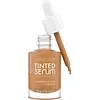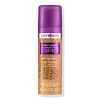What's inside
What's inside
 Key Ingredients
Key Ingredients

 Benefits
Benefits

 Concerns
Concerns

 Ingredients Side-by-side
Ingredients Side-by-side

Water
Skin ConditioningIsododecane
EmollientDimethicone
EmollientGlycerin
HumectantC12-15 Alkyl Benzoate
AntimicrobialPEG-10 Dimethicone
Skin ConditioningHydrogenated Polydecene
EmollientDimethicone Crosspolymer
Emulsion StabilisingButylene Glycol
HumectantCetyl PEG/PPG-10/1 Dimethicone
EmulsifyingSilica
AbrasiveTrimethylsiloxysilicate
EmollientTocopheryl Acetate
AntioxidantSodium Hyaluronate
HumectantSodium Chloride
MaskingMagnesium Sulfate
Triethoxycaprylylsilane
Disteardimonium Hectorite
StabilisingMethicone
EmollientPropylene Carbonate
SolventEthylhexylglycerin
Skin ConditioningPhenoxyethanol
PreservativeSodium Benzoate
MaskingSodium Dehydroacetate
PreservativeBenzoic Acid
MaskingDehydroacetic Acid
PreservativeAluminum Hydroxide
EmollientCI 77491
Cosmetic ColorantCI 77492
Cosmetic ColorantCI 77499
Cosmetic ColorantCI 77891
Cosmetic ColorantWater, Isododecane, Dimethicone, Glycerin, C12-15 Alkyl Benzoate, PEG-10 Dimethicone, Hydrogenated Polydecene, Dimethicone Crosspolymer, Butylene Glycol, Cetyl PEG/PPG-10/1 Dimethicone, Silica, Trimethylsiloxysilicate, Tocopheryl Acetate, Sodium Hyaluronate, Sodium Chloride, Magnesium Sulfate, Triethoxycaprylylsilane, Disteardimonium Hectorite, Methicone, Propylene Carbonate, Ethylhexylglycerin, Phenoxyethanol, Sodium Benzoate, Sodium Dehydroacetate, Benzoic Acid, Dehydroacetic Acid, Aluminum Hydroxide, CI 77491, CI 77492, CI 77499, CI 77891
Water
Skin ConditioningGlycerin
HumectantHexyl Laurate
EmollientPropanediol
SolventOctyldodecanol
EmollientPentylene Glycol
Skin ConditioningBenzyl Alcohol
PerfumingBakuchiol
AntimicrobialDisteardimonium Hectorite
StabilisingAluminum Hydroxide
EmollientCarbomer
Emulsion StabilisingAmodimethicone
Propylene Carbonate
SolventTrisodium Ethylenediamine Disuccinate
Acrylates/C10-30 Alkyl Acrylate Crosspolymer
Emulsion StabilisingSodium Lauroyl Glutamate
Lysine
Skin ConditioningSodium Hydroxide
BufferingAlcaligenes Polysaccharides
EmollientMagnesium Chloride
Tranexamic Acid
AstringentWater, Glycerin, Hexyl Laurate, Propanediol, Octyldodecanol, Pentylene Glycol, Benzyl Alcohol, Bakuchiol, Disteardimonium Hectorite, Aluminum Hydroxide, Carbomer, Amodimethicone, Propylene Carbonate, Trisodium Ethylenediamine Disuccinate, Acrylates/C10-30 Alkyl Acrylate Crosspolymer, Sodium Lauroyl Glutamate, Lysine, Sodium Hydroxide, Alcaligenes Polysaccharides, Magnesium Chloride, Tranexamic Acid
 Reviews
Reviews

Ingredients Explained
These ingredients are found in both products.
Ingredients higher up in an ingredient list are typically present in a larger amount.
Aluminum Hydroxide is a form of aluminum. It can be naturally found in nature as the mineral gibbsite. In cosmetics, Aluminum Hydroxide is used as a colorant, pH adjuster, and absorbent.
As a colorant, Aluminum Hydroxide may add opacity, or reduce the transparency. Aluminum hydroxide is contains both basic and acidic properties.
According to manufacturers, this ingredient is an emollient and humectant. This means it helps hydrate the skin.
In medicine, this ingredient is used to help relieve heartburn and help heal ulcers.
There is currently no credible scientific evidence linking aluminum hydroxide in cosmetics to increased cancer risk.
Major health organizations allow the use of aluminum hydroxide in personal care products and have not flagged it as a carcinogenic risk at typical usage levels.
Learn more about Aluminum HydroxideDisteardimonium Hectorite comes from the clay mineral named hectorite. It is used to add thickness to a product.
It can also help stabilize a product by helping to disperse other ingredients.
Hectorite is a rare, white clay mineral.
Learn more about Disteardimonium HectoriteGlycerin is already naturally found in your skin. It helps moisturize and protect your skin.
A study from 2016 found glycerin to be more effective as a humectant than AHAs and hyaluronic acid.
As a humectant, it helps the skin stay hydrated by pulling moisture to your skin. The low molecular weight of glycerin allows it to pull moisture into the deeper layers of your skin.
Hydrated skin improves your skin barrier; Your skin barrier helps protect against irritants and bacteria.
Glycerin has also been found to have antimicrobial and antiviral properties. Due to these properties, glycerin is often used in wound and burn treatments.
In cosmetics, glycerin is usually derived from plants such as soybean or palm. However, it can also be sourced from animals, such as tallow or animal fat.
This ingredient is organic, colorless, odorless, and non-toxic.
Glycerin is the name for this ingredient in American English. British English uses Glycerol/Glycerine.
Learn more about GlycerinThis ingredient is a solvent. It helps dissolve active ingredients and alter the texture of products.
Propylene Carbonate is commonly used in makeup and with clay, such as montmorillonite or bentonite.
Studies show this ingredient to be safe for cosmetics. When it is undiluted, it can cause skin irritation. (It is always diluted in skincare and makeup). This ingredient is water-soluble.
Propylene Carbonate is created from propylene glycol and carbonic acid.
Learn more about Propylene CarbonateWater. It's the most common cosmetic ingredient of all. You'll usually see it at the top of ingredient lists, meaning that it makes up the largest part of the product.
So why is it so popular? Water most often acts as a solvent - this means that it helps dissolve other ingredients into the formulation.
You'll also recognize water as that liquid we all need to stay alive. If you see this, drink a glass of water. Stay hydrated!
Learn more about Water